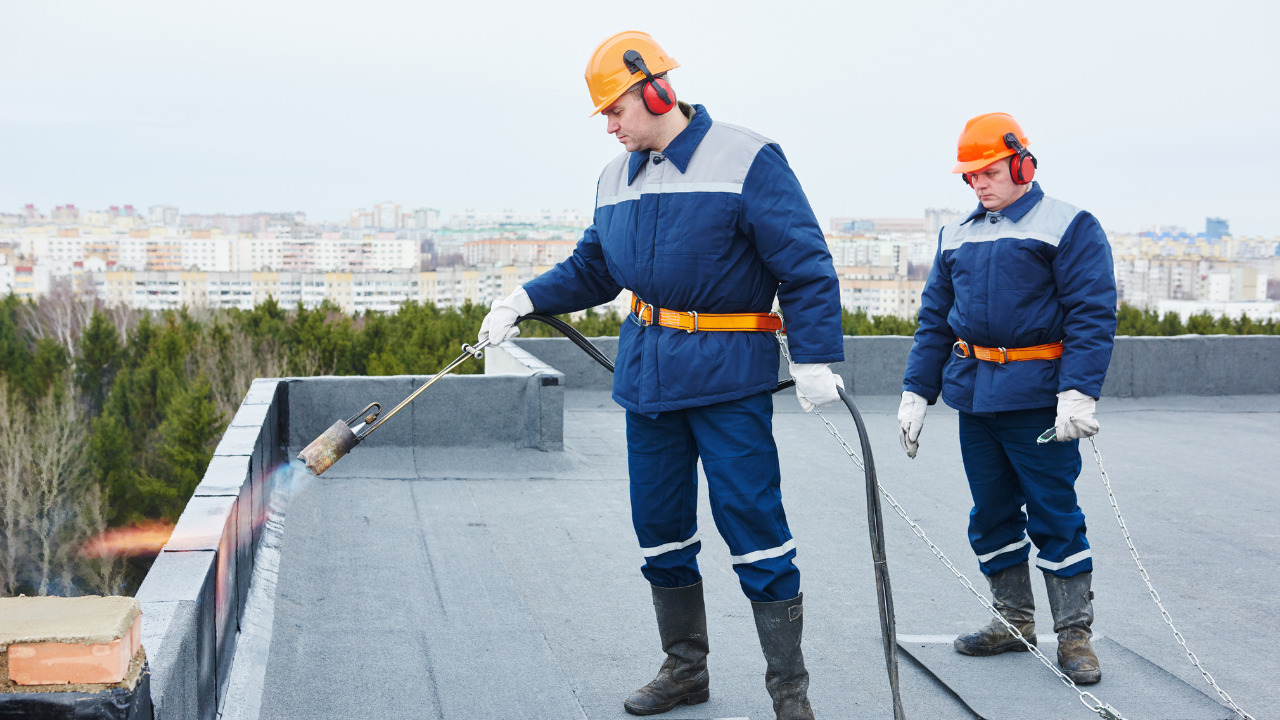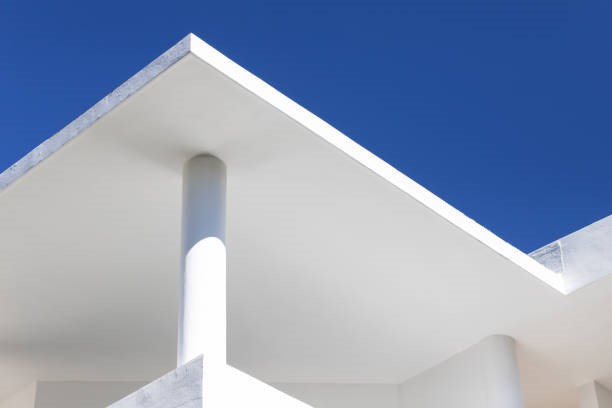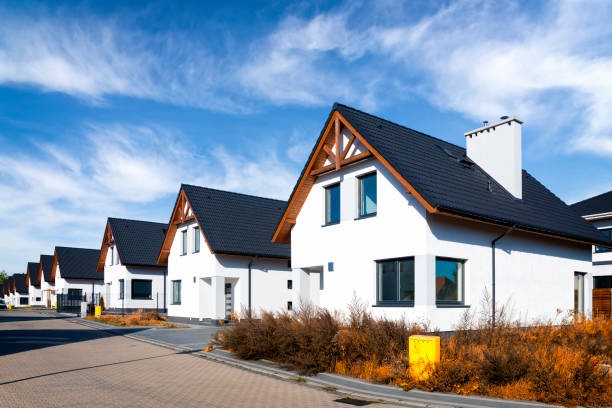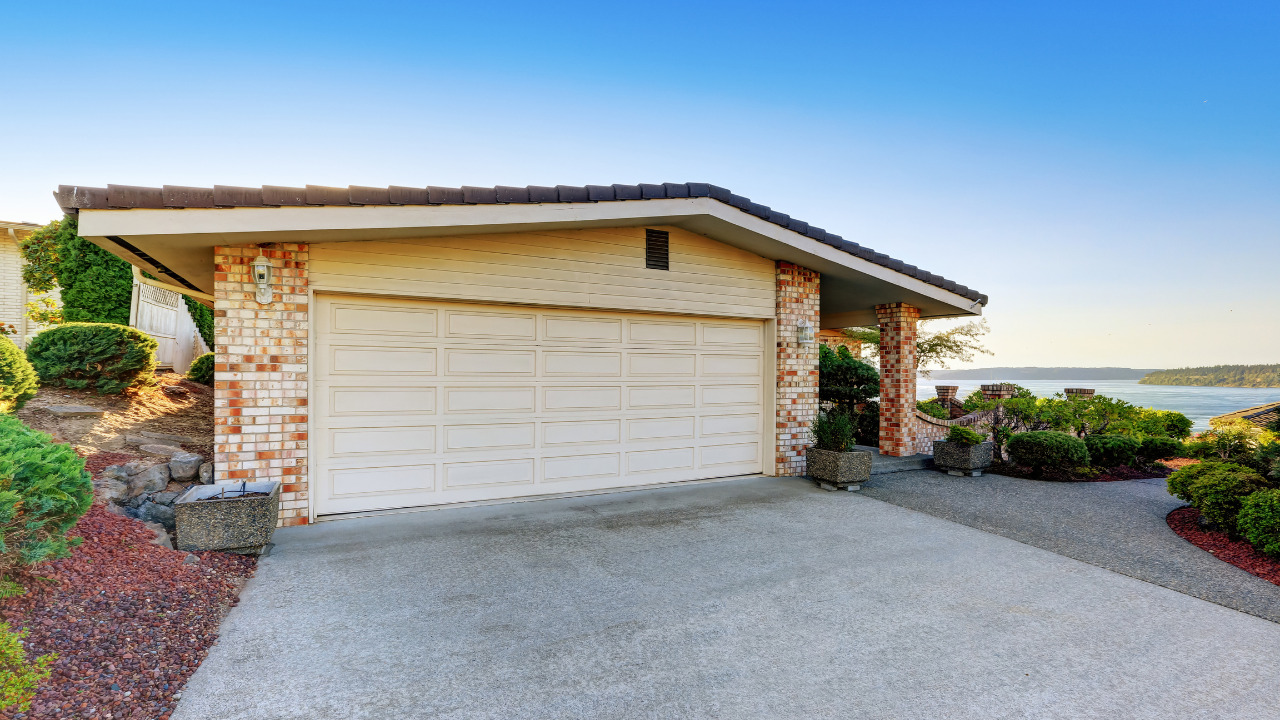Concrete is a mixture of cement, sand, coarse aggregates and water and its usage as a construction material accounts for a vast majority of construction works carried out globally. From residential buildings to commercial centers, parking lots, stadiums, bridges and whatnot, concrete can be used for essentially all types of structural works.
Roof concrete simply refers to the concrete that is used to make roof of any story of a building. Concrete is a very common material used in roof slabs that may or may not rest on beams.
The roof of a building is the top level of any story that bears the loads coming from the story above and transfers them to the underlying story structure (beams, walls, columns, etc.). For any building type, an emphasis must be laid on proper roof design and construction. This includes properly handling the concrete and steel reinforcement (if any).
Table of Contents
What Should be the Properties of a Good Roof Concrete?
Concrete as a roofing material should possess certain properties that mark its use as suitable for the intended function. Some of these properties are given as follows;
- The concrete should possess a fairly good compressive strength, in no case less than 20 MPa. This is to ensure that apart from bearing the dead and live loads, the concrete roof is capable of withstanding forces of winds or any other unexpected loading.
- The concrete should also be durable. The word durability in material sciences refers to a material’s resistance to environmental factors. Concrete that is durable will perform well under harsh environments such as chloride attacks, sulfate attacks, etc.
- Any type of concrete serving any purpose (except for permeable concrete) should be resistant to the ingress of moisture. This is because when water infiltrates into the concrete, it weakens the matrix and may lead to disintegration over time.
- In wet or plastic state, a good roof concrete is one which is workable and easy to place, compact and finish the surface. To achieve this, the water-to-cement ratio of the concrete mix is to be regulated carefully.
- Concrete, as material, has a tendency to shrink as water evaporates from the mix and it begins to harden. However, excessive shrinkage can lead to early cracking in the concrete, reducing the member’s load-bearing capacity and hence, its performance.
- A good concrete for roof should possess a good thermal resistance so that it is capable of withstanding temperature cycles without cracking. In other words, the coefficient of thermal expansion should be less.
How to Carry Out the Concrete Work for a Roof?
Concrete work in roof is just the same as that for any structural concrete member. From the design to placement of concrete and its finishing, every step needs to be executed with precision so that your structure is well capable of performing its intended function.
Particularly talking about the roof component of a building, it has to bear the story loads from the overlying part of the building and if it fails to do so appropriately, what else would you expect if not a collapse or structural damage?
As far as the concrete work for roof is concerned, following is a step-by-step guideline for you;
- The first step is to design the roof or concrete slab considering all the anticipated loads in its service life. Proper design also includes proper selection of materials, reinforcement, and quality control on part of the contractor. The design process involves determining the type of concrete roof you will go for your structure, its size, shape, and thickness, the amount of reinforcement it requires, the requirement of any supporting beams, etc. Once you have decided and designed your concrete roof, you are good to go with the construction work on site.
- Erect the formwork that will serve as a mold for pouring concrete. The formwork can be of any material such as wood, steel, etc. but the concrete should not stick to its surface and it should be reusable and economical, too. Make sure the formwork is practically level and its surface is clear of any imperfections.
- Place the steel reinforcement at the designated location before the concrete is placed in the formwork.
- Prepare concrete by first batching the ingredients as per the mix design and then mix them in a concrete mixer to prepare a consistent and workable concrete mix.
- Pour the concrete into the formwork from a suitable height that prevents bleeding or segregation in concrete. The concrete is poured till the required roof thickness is achieved.
- Level the surface to remove any irregularities and give it a finished look.
- Cure the concrete using any curing technique such as jute bags, ponding, etc. for the required period for it to gain its promised strength.
- Once the curing of concrete is carried out, remove the formwork carefully and avoid any potential damage to the concrete member while removing the it.
- You may then apply any surface coatings such as a sealant or paint to protect the surface of concrete and ensure longevity.
Reinforcement in Roof Concrete
Roof concrete is typically reinforced with steel bars or mesh reinforcement. The purpose of providing this reinforcement is to be prevent early onset of tensile cracking in the concrete and make the member ductile.
To reinforce a concrete roof, the following reinforcement types may be provided depending upon need.
- Steel reinforcement in the form of deformed bars is the most commonly used method of reinforcing the roof. Different steel grades such as grade 40, 60, etc. are available in the markets and they are simply embedded in the slab at the required depth. It is to be kept in mind that the main reinforcement in case of concrete roofs is provided on the side that is anticipated to develop tensile stresses. The other side is only nominally reinforced against shrinkage cracking.
- Fiber reinforcement can also be accommodated inside the concrete mix at the design stage. These small discrete particles can be made of materials such as steel, glass, synthetic polymers, plastic, etc. These fibers improve the resistance of concrete to propagation of cracking by improving the bond between the individual concrete components.
- Carbon fiber reinforcement is another advanced repair and reinforcement method for concrete roofs. It is lightweight and possess a very high tensile strength. It can be applied in thin layers and molded according to the shape of the roof.
- Pre-stressing reinforcement can also be used to reinforce and strengthen roof concrete. This involves providing pre-stressing steel bars or wires and tensioning them to a certain stress level before the member is actually loaded. This can help reduce cracking in concrete and allow the member to utilize its full capacity across its depth.
The type of reinforcement you use in your slab will depend on various factors, the most important of which are the anticipated loading and environmental conditions.
Roof Concrete Designs
Several finishes can be given to a concrete roof depending upon the desired look you want to achieve. Various coatings can be applied on the roof concrete to serve multiple causes such as improving its aesthetics, reducing heat absorption (by using a reflective coating), improving energy efficiency of the building, etc.
In addition, you can also customize the color of the roof with a wide variety of paints available in the market. Some stamping may also be done to impart a certain imprint on the surface. The stamping is done using special stamps of various textures and prints and are simply pressed on the surface to get the desired look.
Types of Concrete Roof
We all know that concrete is a versatile material and can be cast into whatever mold you provide it. Even for structural members, the design is not confined to a flat plate placed as a roof to bear the story loading.
Many types of roofs can be cast using reinforced concrete and each type offers its own benefits. The following are some of the concrete roofs you can go for, for your structure.
Flat Concrete Roofs
As the name indicates, flat roofs are practically level with no inclination or slope. They are very common in petrol stations, parking lots, industrial buildings, and commercial buildings. They comprise a reinforced concrete slab of sufficient thickness that is placed on top of either columns or walls that transfer the loading from above to the foundations.
Flat roofs are very easy to construct and maintain. However, in high seismic zones, they are not preferred because the structure as whole is not the strongest to bear the whiplash of seismic waves. In addition, in areas where there are greater chances of snowfall or other forms of precipitation, a flat roof is not a wise choice. This is because the snow might get accumulated and draining it off the roof will require manual effort. In such cases, a pitched roof is a must.
In addition, when the loading that is to be supported is very heavy, going for only a flat roof supported on columns will require a very thick slab which will prove to be counter-productive owing to its colossal self-weight. In such cases, it is preferable to support the flat slab on beams that rest on underlying columns.
One advantage of using a flat roof is that the roof top can be utilized as some additional space for solar panels or air conditioning systems.
Pitched Concrete Roofs
This type of concrete roof is pitched or sloped and the purpose of providing it is to allow water and snow to drain off from the roof top instead of getting accumulated. They are most commonly used in residential buildings and can entail great variety in construction techniques.
Waffle Concrete Slab
Oftentimes, it is not desirable to make a structural element too big to support the overlying loads that it becomes difficult for the underlying structural members to support it. Wait, hang on! We know you haven’t gotten it straight yet. Let me give you an example.
If the anticipated loading on a roof is very large (say it has to support heavy equipment or machinery along with other dead, superimposed and live loads), the concrete slab required to support it will be too thick. In other words, the required slab depth for such a loading may occupy too much space of a story height. In addition, such as thick slab will necessitate providing very strong foundations and you know what you are doing? You are simply adding up costs on tops of each other.
A wise solution is to reduce the structure’s dead weight so that you do not require too heavy a foundation and also, you will get some cost saving in materials. Waffle concrete roof is just the right choice in such a situation.
As the name shows, waffle roof is just like the waffles everyone loves to eat. It comprises hollow rectangles interconnected with each other and provide an aesthetic look of the interior side. It is very common in auditoriums, conference halls, etc.
Vaulted Concrete Roofs
Vaulted concrete roofs are used to support large structural weights and are commonly found in large-span buildings such as sport complex, airports, etc. They comprise a curved roof in 3 dimensions in the form of an arch that augments the structural integrity of the system.
Dome-Shaped Concrete Roofs
Domes-shaped roofs are also the go-to option for large buildings and centers. A dome or arch is a very strong structure that allows greater loads to be supported. It is also visually attractive and strong as well as provides a spacious interior.
Ribbed Concrete Roofs

A ribbed concrete roof is one in which there are a series of beams that run in both directions and support the roof slab. It is often used where a high degree of strength and structural stability is required. It is commonly used in industrial buildings.
Failure Modes of Roof Concrete
Concrete that used to construct roof can fail in a number of ways; it can either be material failure in the form of crushing of concrete or structural failure in the form of punching or settlement. Whatever be the mode of failure, it is important to properly design the roofs so that they perform appreciably well in their anticipated service life.
A concrete roof also fails when the reinforcement in it gets corroded. In such a case, the bond between the steel and concrete is lost because of the presence of rust. Loss of bond means that steel and concrete are no longer behaving as one and if that happens, the tensile stresses are no longer taken up by steel and concrete becomes the front liner for bearing these stresses. Since concrete is weak in tension, the member will entirely collapse the instant the tensile strength of concrete gets exhausted.
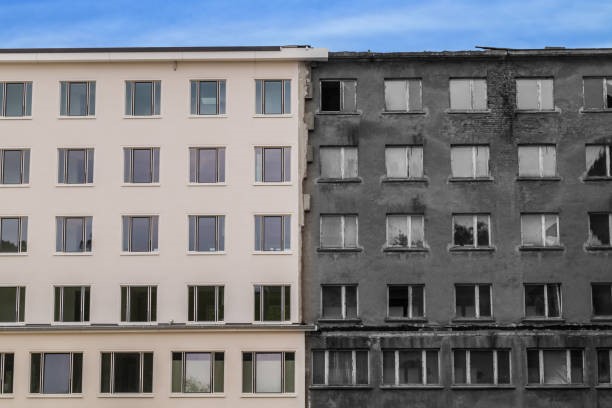
In addition, deflection in a concrete roof can also take place because of a failure in the supporting members. This can lead to cracking and damage in concrete.
Punching failure mode is also common in flat plates that rest on columns. In this case, what happens is that if the cross-sectional area of column is less, it punches into the slab if adequate shear resistance is not available or provided by the slab. Therefore, when designing a concrete slab, you must check for the punching shear and if the check fails, you out to improve the shear strength of the slab by either increasing its thickness, providing a drop panel, or any shear reinforcement (shear heads).
Creep and shrinkage-induced cracking in concrete can also lead to a reduction in the capacity of the member. This means that the concrete roof is now able to bear less loads than what it was actually designed for.
Thermal expansion and contraction can also lead to cracking in concrete. To prevent these cracks, usually expansion joints are provided.
If the roof does have an adequate drainage path, the added load of precipitation (snowfall, impounded water, etc.) can damage the concrete and it will develop cracking over time.
Frequently Asked Questions (FAQs)
Differentiate between segregation and bleeding in concrete?
Segregation and bleeding are both indicative of a defective concrete mix that is either not proportioned well or the ingredients are not thoroughly mixed. However, oftentimes, both these terms and confused with each other and are also considered the same mistakenly.
Segregation refers to a phenomenon in which as you pour concrete, the aggregate particles get separated from the concrete matrix and it seems like the coarse aggregates and cement paste are travelling individually instead of a cohesive mix. It can take place owing to a number of reasons such as,
- Using very large coarse aggregates in the concrete mix
- Pouring concrete from a greater height
- Insufficient vibration of concrete
- Concrete mix being very dry indicating that the water-to-cement ratio is not closely monitored
The aftermath of segregation in concrete is the formation of voids or air pockets in it. There are surface irregularities and the hardened concrete will appear as if the coarser aggregates have accumulated on one side, leaving the cement matrix on the other side.
On the other hand, bleeding in concrete is similar to bleeding that occurs in living organisms when the blood inside the body seeps out of a wound and keeps flowing out. When concrete bleeds, water in the mix comes at the top of it and forms a thin layer. It looks like as if the top layer of concrete is very flowable and the bottom one is relatively less flowable.
A number of factors can be made accountable for bleeding in concrete. These include the following;
- Over-vibration of concrete can lead to water coming at the top surface
- Using a concrete having a large water-to-cement ratio making it very flowable and wet
- Presence of large number of medium-sized particles in the concrete
Defects such as reduced strength and durability, high porosity, etc. often become apparent with this phenomenon of bleeding. Hope this ambiguity is cleared now!
Can roof concrete be cast without reinforcement?
A roof is a structural element of a building and depending upon the dimensions of one roof panel, it bends in one way or two-way directions. When the load is applied on the roof, bending stresses are developed in it. As a result, a part of it comes in tension and a part goes in compression.
The part of concrete that develops compression stays happy because concrete is strong against compression. However, the part in tension is inherently so weak that the instant concrete reached its tensile strength (which is roughly 10 percent of its compressive strength), the member fails instantly without any warning.
Therefore, it is always advisable to go for reinforced concrete if your roof has to serve a structural cause. However, you must be thinking that if there is no loading or very less loading expected on the roof, you can go for plain concrete.
If that is the case, it means that the roofing material is only to be provided as a building cover or enclosure and we recommend using other economical options in that case instead of going for concrete.
What should be the minimum thickness of a concrete roof?
The required thickness of a concrete roof is to be determined by appropriate design calculations by taking into consideration the roof size, expected loading, target service life, environmental factors, etc.
However, even some codes of practice have restricted the lower limit for a concrete slab thickness in order to prevent punching shear or other failures in the slab. For flat roofs (with no pitching), the minimum recommended thickness of roof is 4 inches. If the roof is sloped, a greater thickness mat be required if wind loads and other lateral forces are expected to strike the building.
What should be the strength of concrete used in roof?
For slabs or roofs, a compressive strength of 3000 psi is adequate and is normally used. However, higher strength concrete may also be used depending upon the building loads and roof span. The concrete strength to be used in roof also depends upon the type of building.
For residential buildings, a strength of 2500 psi is also considered sufficient but this value may reach 4000 psi depending upon the loading.




